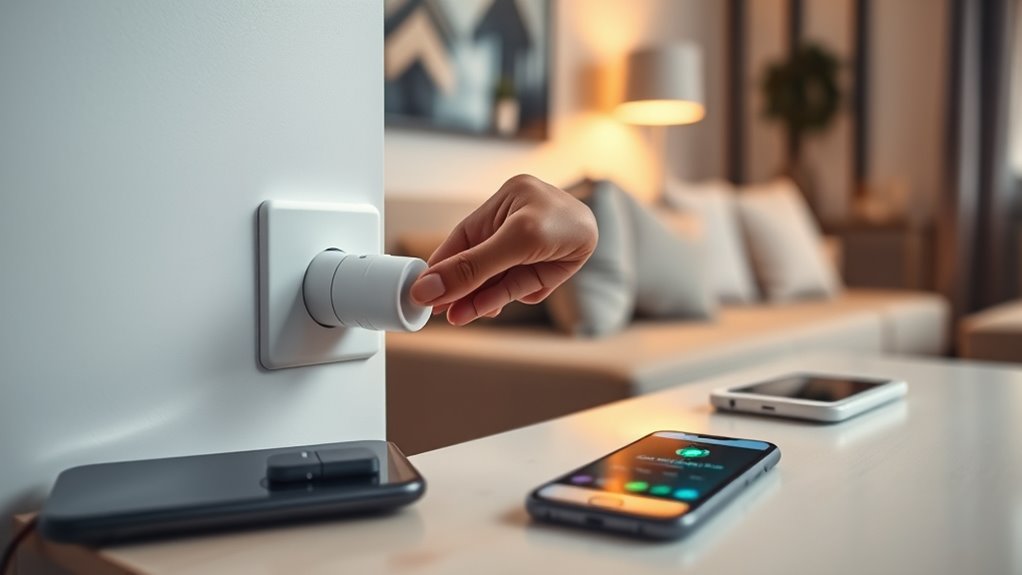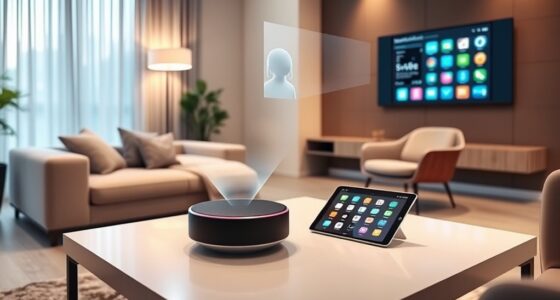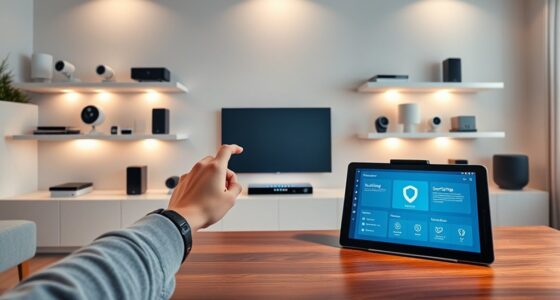Smart plugs are Wi-Fi-enabled devices that plug into your outlets, allowing you to control connected electronics remotely via smartphone apps or voice commands. They help save energy by scheduling devices to turn on or off automatically, boost convenience with remote control, and enhance safety by turning off appliances when needed. There are different types for indoor and outdoor use to suit your needs. Keep exploring to discover how to set them up and get the most out of your smart home.
Key Takeaways
- Smart plugs are Wi-Fi-enabled devices that control connected electronics remotely via smartphone apps or voice assistants.
- They enable scheduling, energy monitoring, and automation to save energy and increase convenience.
- Setup involves plugging into an outlet, connecting to Wi-Fi, and pairing with a compatible app and voice assistant.
- They come in indoor and outdoor types, designed for different environments and device compatibility.
- Troubleshooting includes resetting, updating firmware, checking Wi-Fi connection, and ensuring proper device pairing.
What Is a Smart Plug and How Does It Work?

A smart plug is a Wi-Fi-enabled device that you plug into a standard outlet to control connected electronics remotely. Once connected, you can manage your devices through a smartphone app, whether you’re at home or away. The smart plug communicates via Wi-Fi, often without needing a hub, making setup simple. You can turn appliances on or off, set schedules, or monitor energy usage directly from the app. Many smart plugs also support voice control, allowing you to control devices with assistants like Alexa or Google Assistant. To get started, just plug the smart plug into an outlet, connect it to your Wi-Fi network, and pair it with the app. From there, controlling your devices becomes quick and effortless, giving you more convenience and flexibility. Additionally, understanding the security aspects of smart devices helps ensure your connected home remains safe. It is also beneficial to consider how energy management features can optimize your device usage and reduce electricity costs. Implementing effective device control can further enhance your overall smart home experience, making daily routines more seamless. Moreover, integrating smart plugs with home automation systems can create more comprehensive and customized living environments. Best Vacuums for Dust Removal in 2024 highlight the importance of effective filtration systems, making smart plugs an excellent addition for managing devices that contribute to indoor dust levels.
Benefits of Incorporating Smart Plugs Into Your Home

Incorporating smart plugs into your home offers numerous benefits, especially when it comes to saving energy and increasing convenience. They make it easy to control devices remotely or set schedules, reducing unnecessary energy use and lowering bills.
With seamless integration into your smart home system, you can use voice control through Alexa or Google Assistant to turn devices on or off effortlessly. Smart plugs also help you identify high-energy-consuming appliances, encouraging more efficient choices.
Automating device operation enhances safety by turning off appliances when not in use, preventing hazards. Plus, they’re a cost-effective way to add smart features to existing electronics without replacing them, boosting your home automation capabilities and making everyday life more efficient and safer.
Additionally, integrating AI technology into your smart home devices can further optimize energy management and provide personalized assistance, making your home even smarter and more responsive. Understanding fraud detection techniques can help ensure that your smart home system remains secure from potential cyber threats.
A comprehensive security strategy is essential to protect your smart devices from vulnerabilities and ensure your home automation remains safe and reliable.
Different Types of Smart Plugs and Their Uses
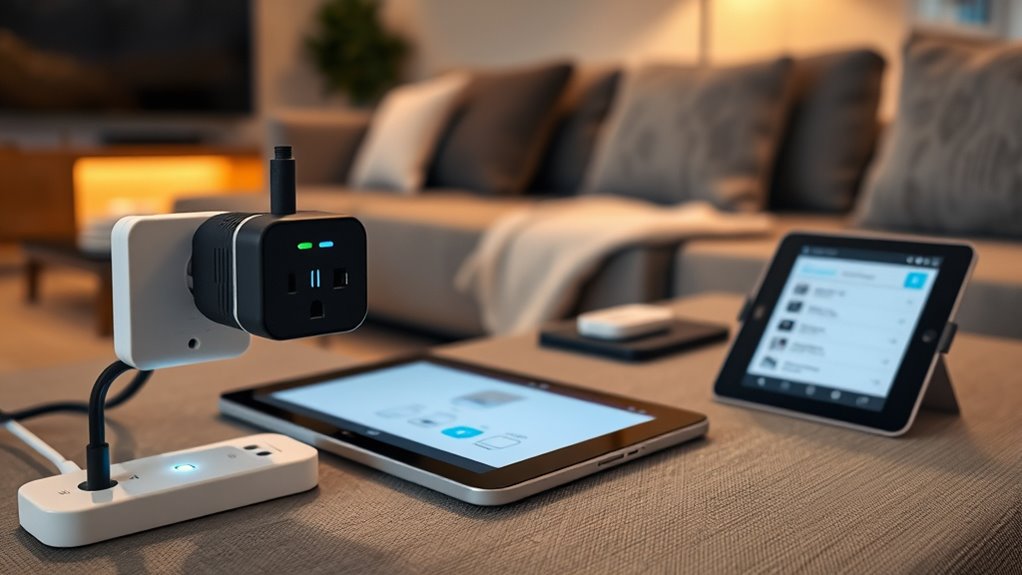
Smart plugs come in two main types designed for different settings: indoor and outdoor. Indoor smart plugs are compact, perfect for tight spaces, and support voice control, scheduling, and energy monitoring. They easily integrate with smart home devices and let you control appliances remotely via smartphone apps. Additionally, many retailers offer extended hours during holidays or peak shopping times, making it easier for you to purchase or inquire about these devices. Understanding the compatibility of your smart plugs ensures seamless integration with your existing smart home ecosystem. Both types support remote control and voice control, giving you convenience and flexibility. Use indoor smart plugs for lamps, coffee makers, or entertainment systems. Outdoor smart plugs are weatherproof with waterproof covers, making them ideal for patios, gardens, and exterior lighting. They feature 3-prong outlets built to withstand rain, wind, and temperature changes. Both types support remote control and voice control, giving you convenience and flexibility. Use outdoor smart plugs for outdoor string lights, garden fountains, or outdoor security equipment, enhancing your smart home ecosystem effortlessly. Incorporating creative problem-solving can help you optimize the placement and functionality of your smart devices for the best performance. Additionally, considering environmental considerations can help you choose energy-efficient models that support sustainable living. Leveraging water safety features in outdoor smart plugs can also prevent electrical hazards near water sources.
Step-by-Step Guide to Installing a Smart Plug

Getting your smart plug ready is simple—just plug it into a wall outlet and make sure it powers on. Next, download the manufacturer’s app and create or log into your account. Then, put the device into pairing mode and follow the app’s instructions to connect it to your Wi-Fi network. Smart home devices can help you maintain a seamless and automated living environment. To ensure optimal performance, familiarize yourself with prophetic dreams and their significance, which can sometimes influence your intuitive understanding of new technology. Understanding family dynamics can also provide valuable insights into managing your smart home setup effectively.
Preparing the Smart Plug
To prepare your smart plug for setup, start by plugging it into a standard wall outlet and making sure it’s powered on. Your next step is to download and install the manufacturer’s app, like Kasa or Cync, on your smartphone or tablet. Once installed, activate pairing mode on the smart plug by pressing and holding its power button until the indicator lights flash. This equips the device for setup. Then, follow the app’s on-screen instructions to connect the smart plug to your Wi-Fi network, usually by entering your Wi-Fi credentials. When the setup is complete, you can name your device and assign it to a specific room or group for easier control. This process ensures your smart plug is ready for seamless operation. Proper setup procedures are essential to ensure your device functions correctly and securely within your smart home ecosystem. Additionally, reviewing privacy policies can help you understand how your data is handled during setup and use. It’s also beneficial to update firmware when prompted to maintain security and performance. To enhance your experience, consider exploring the latest smart home trends, which include better integration with other devices and new features to optimize your setup. Furthermore, understanding the security features of your smart plug can help protect your connected devices from potential threats.
Connecting to Your Network
Wondering how to connect your smart plug to your Wi-Fi network? First, plug it into a standard wall outlet and make sure it’s powered on.
Download the manufacturer’s app, like Kasa, OhmConnect, or Cync, and open it. Create an account or log in if needed.
Follow the app instructions to put the smart plug into pairing mode—usually by pressing and holding a button until the indicator light flashes.
Next, connect the smart plug to your Wi-Fi network within the app, making sure you’re on a 2.4 GHz Wi-Fi network, as it’s the most compatible.
The pairing process is straightforward, and once connected, your smart plug will be ready to control through the app, allowing you to manage your devices effortlessly.
Being aware of security vulnerabilities associated with new technologies can help you take extra precautions during setup.
How to Pair Smart Plugs With Voice Assistants and Smart Home Systems
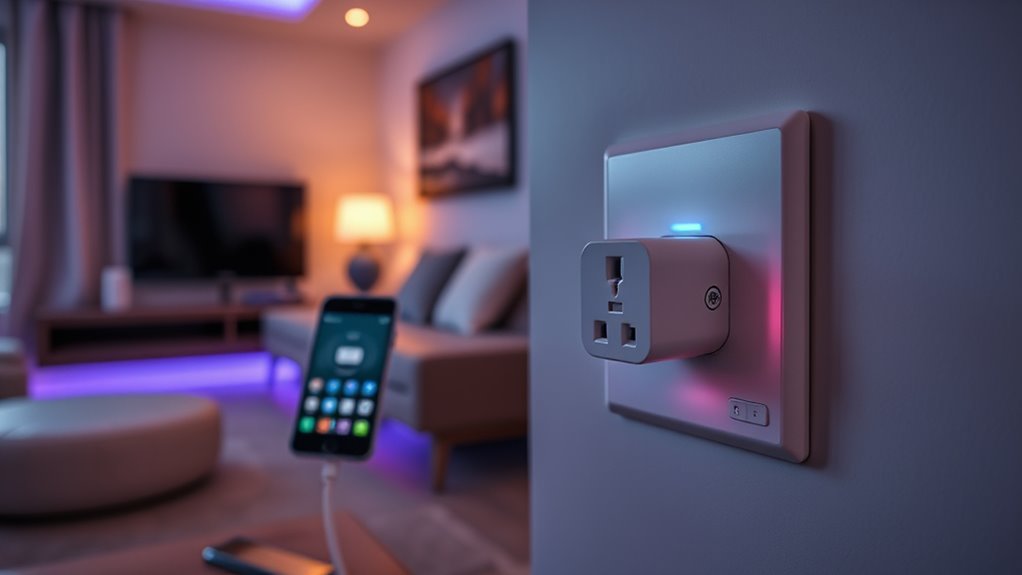
Pairing your smart plug with voice assistants like Alexa or Google Assistant is a straightforward process that enhances your smart home experience. First, set up your smart plug through its smart home app and connect it to your Wi-Fi network.
Then, enable the relevant skill or service in your voice assistant’s app, following the instructions to link your smart plug account for seamless device connection. Many smart plugs support direct pairing within their app by selecting the device and enabling voice assistant integration in settings.
- Use the smart home app to assign clear, descriptive names to your smart plugs.
- Follow prompts for pairing and linking accounts for smooth control device setup.
- Speak voice commands like “Alexa, turn on the living room lamp” to control your devices effortlessly.
Practical Ways to Use Smart Plugs for Energy Saving and Convenience

Smart plugs offer practical solutions for saving energy and boosting convenience around your home. You can schedule and automate devices like lights and chargers to turn off during off-peak hours, reducing energy consumption and lowering bills. Using smart plugs for remote control lets you switch off forgotten devices, preventing waste and improving safety. Monitoring energy use helps identify high-consuming devices, enabling smarter energy decisions. Automate routine tasks, such as outdoor lights at sunset or sunrise, saving time and enhancing home security. Voice assistants make control effortless.
| Control Method | Benefit |
|---|---|
| Scheduling | Saves energy and time |
| Remote Control | Prevents unnecessary waste |
| Automation | Enhances convenience and safety |
This approach maximizes energy saving and convenience seamlessly.
Troubleshooting Common Issues With Smart Plugs
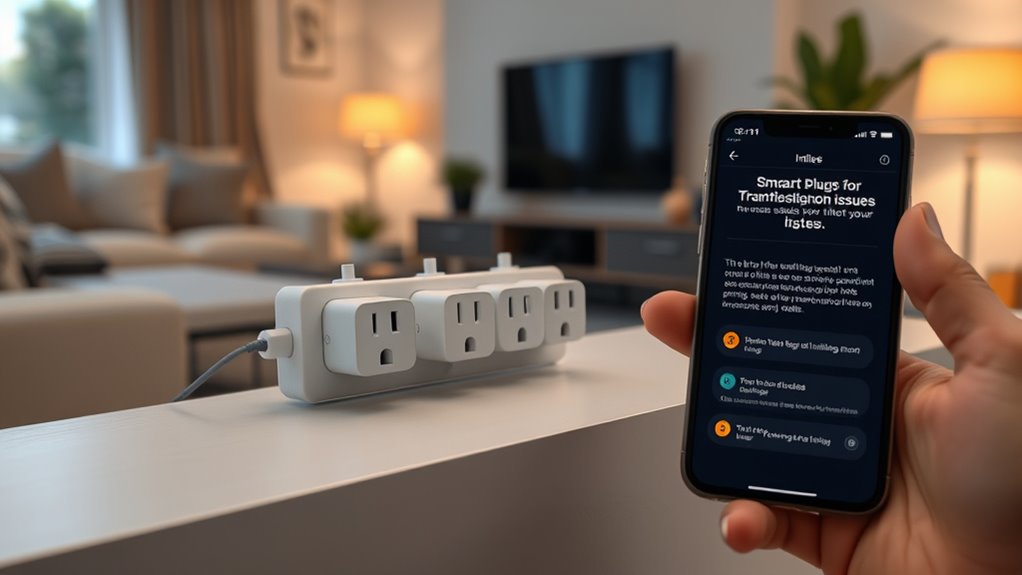
When your smart plug stops responding, the first step is to reset it by unplugging and then re-pairing it through the app. This often resolves connectivity issues and restores proper functioning.
If problems persist, check your Wi-Fi network’s stability and range, as weak signals can cause setup and connection issues.
Updating the firmware via the app can also fix bugs and improve performance.
If your smart plug continues to malfunction, consider resetting it to factory settings, which can clear persistent issues but requires reconfiguring your setup.
To troubleshoot effectively, keep these tips in mind:
- Verify Wi-Fi credentials before re-pairing
- Ensure firmware is up to date
- Reconfigure after a factory reset
Cost Considerations and Choosing the Right Model
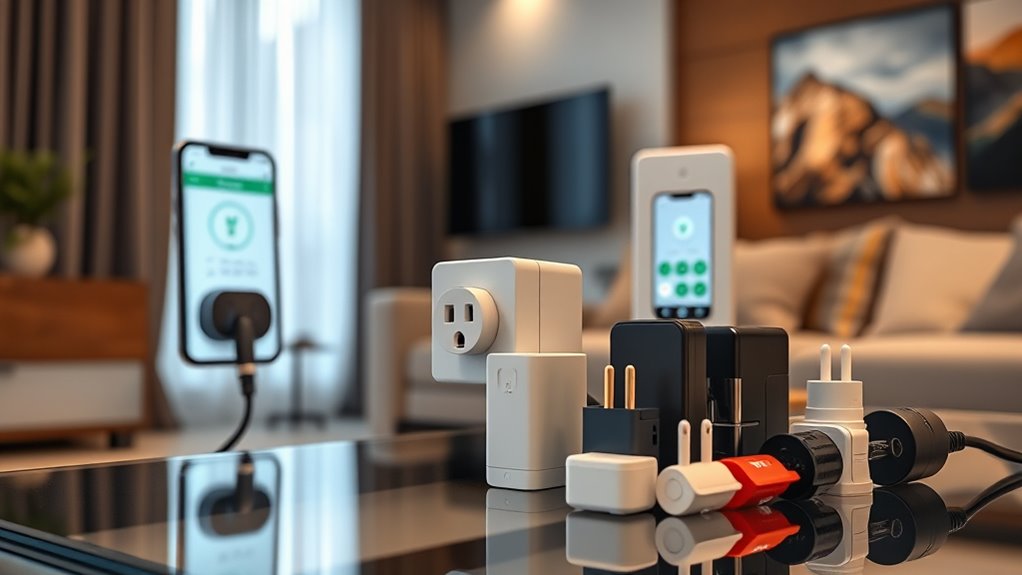
When selecting a smart plug, you need to weigh your budget against the features you want. Cheaper models like the Kasa HS105 may suit basic needs.
While premium options offer more automation and energy monitoring. Consider what’s most important for your setup to find a model that balances cost and functionality.
Cost Comparison and Budgeting
Are you trying to find a smart plug that fits your budget without sacrificing essential features? Smart plug prices vary from under $15 for basic models to around $30 for outdoor or feature-rich options.
When comparing options, consider:
- The price and whether it fits your budget
- Compatibility with your existing smart home system
- Features like scheduling, energy monitoring, or USB ports
Budget-friendly models typically lack advanced energy savings but still offer remote control.
Higher-priced options often include additional outlets, better compatibility, and more versatile features, providing greater value.
Balancing cost and features ensures you get a device that meets your automation needs without overspending. By carefully evaluating these factors, you can choose a smart plug that delivers the best value for your money.
Features vs. Price Balance
Balancing features and price is key to selecting the right smart plug for your needs. Basic models under $15 offer essential features like remote on/off control and scheduling, perfect for simple tasks.
If you want advanced functionalities such as energy monitoring, multiple outlets, or enhanced scheduling, higher-priced smart plugs—around $30 or more—bring added benefits like outdoor durability and broader compatibility with smart home ecosystems.
Consider which features are truly necessary for your setup, whether voice control, timers, or app integration. Checking customer reviews and product specifications helps you determine if a pricier model offers real value over cheaper options.
Ultimately, a smart plug’s cost should align with your automation goals and the features that matter most to you.
Model Selection Tips
Choosing the right smart plug depends largely on your budget and specific needs. When doing your model selection, consider what features matter most to you.
- For basic control and scheduling, budget-friendly smart plugs under $15 work well but lack advanced energy monitoring.
- If you want energy saving insights, look for models with energy monitoring, often priced around $20-$30.
- Compatibility is key—ensure your smart plug works with your existing ecosystem like Alexa, Google Assistant, or Apple HomeKit.
Reliability also matters; investing in reputable brands like Kasa or GE can save headaches with firmware updates and customer support.
Balancing cost with features, compatibility, and reliability will help you choose the perfect smart plug for your setup.
Enhancing Your Smart Home With Multiple Devices and Automation
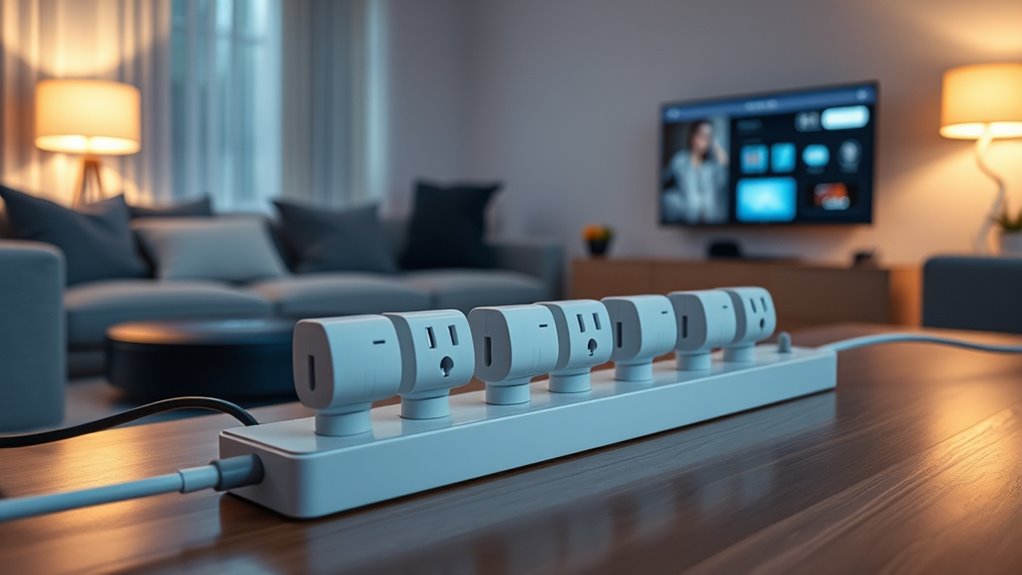
Enhancing your smart home becomes more effective when you use multiple smart plugs together to automate routines and coordinate devices. By integrating several plugs, you can create seamless automation that controls lighting, appliances, and security systems, making your home more cohesive.
Voice commands with Alexa, Google Assistant, or Apple HomeKit simplify control, allowing you to activate scenes or routines effortlessly.
Scheduling your smart plugs enables you to automate complex tasks, like turning on outside lights and brewing coffee at specific times.
Monitoring energy consumption across multiple devices helps identify high-energy appliances, improving energy efficiency and reducing costs.
Coordinating smart plugs with security systems and timers boosts safety, automating holiday lighting and ensuring devices operate only when needed, optimizing your home’s overall performance.
Frequently Asked Questions
What Do You Use Your Smart Plug For?
You use your smart plug to make daily life easier and more efficient. By automating your lamps, fans, or coffee makers, you save time and energy.
You can control devices remotely, schedule their operation, or turn them off when not needed.
With voice commands, managing your home becomes hands-free.
Smart plugs help you stay organized, reduce energy bills, and add convenience to your routine effortlessly.
What Are the Disadvantages of Smart Plugs?
Did you know that nearly 30% of smart home devices face cybersecurity threats? When it comes to smart plugs, one disadvantage is they can expose your network to hacking if not secured properly.
You might also lose remote control during internet outages, or face compatibility issues with your devices. Plus, increased standby power and over-reliance on automation can lead to higher energy use and forgotten routines.
What Is the Difference Between a Smart Outlet and a Smart Plug?
You want to understand the difference between a smart outlet and a smart plug. A smart outlet is built into the wall or installed directly, controlling multiple devices or outlets with advanced features like energy monitoring.
In contrast, a smart plug is a portable device you plug into existing outlets to control individual devices.
Smart outlets offer broader control, while smart plugs are more affordable and easier to set up.
How to Connect Smart Plugs to Wi-Fi?
Did you know over 80% of smart device owners connect their gadgets to Wi-Fi?
To connect your smart plug, first download the app and create an account.
Plug it into an outlet, then press and hold its power button until the LED flashes.
Open the app, follow the prompts to select your Wi-Fi network, enter your password, and finish by naming your device.
Easy, right?
Do Smart Plugs Work Without Internet?
You might wonder if smart plugs work without internet. It depends on the model. Many require an internet connection for remote control and scheduling, but some can operate locally via Bluetooth or direct Wi-Fi pairing.
Without internet, voice commands and cloud features won’t work, but you can often still control the plug manually or through a local app. Check your specific smart plug’s capabilities to know for sure.
Conclusion
Smart plugs can seamlessly transform your home into a smarter, more convenient space. As you explore their features, you might find yourself surprised at how simple automation can be—sometimes, the smallest devices make the biggest difference. With just a few steps, you could be saving energy and enhancing comfort without even realizing it. So why not give it a try? After all, the right smart plug might just be the coincidence your home needs to work smarter for you.
